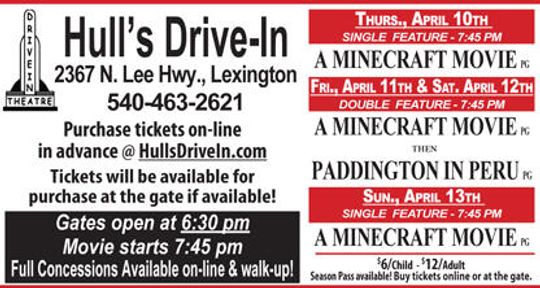Last week, the Lexington Planning Commission voted 5-1 to recommend approval of a conditional use permit application by John Adamson to allow Washington and Lee University to utilize space in the Rockbridge Building on South Main Street for office space and a public assembly area.
The permit was first brought to the Commission at its Aug. 26 meeting, but was tabled. Another permit request submitted by Adamson at that meeting, for the old courthouse building located at 2 S. Main St., was approved by the Commission.
Prior to the discussion on the conditional use permit, the Commission received a brief presentation from Lexington City Manager Tom Carroll regarding payments from the university to the city, particularly in regards to taxes. The information was requested by members of the Planning Commission in order to better understand what impact, if any, renting this space to W&L would have on the city’s tax revenues.
Most of the property owned by W&L is tax exempt, but the university does make payments in lieu of taxes to the city. The city also charges a service fee to residential properties which applies to properties the university owns outside of its campus. In total, W&L pays $765,135 to the city in relation to its properties, not including other fees such as water and sewer fees.
Carroll also noted that property the university rents in the city is not tax exempt, though the taxes are paid by the owner and not the school. Adamson rents a number of properties to the university, and pays more than $55,000 in real estate taxes on those properties.
In his report on the conditional use permit, City Planner Arne Glaeser addressed concerns about the fact that work had been done on the building in question prior to the application for the conditional use permit and that construction on the space has largely been completed.
The issue, he explained, was caught when Adamson applied to renew the permit for the courthouse building earlier this year. In the years since that permit was first issued, a new use had been added to the city’s code for an Educational Facility, College/University, which is defined as “An educational institution authorized by the Commonwealth of Virginia to award associate, baccalaureate or higher degrees, and facilities associated with it,” and includes “academic buildings, administrative facilities, dormitories, special housing, parking areas, dining halls and other physical plants associated with the college or university use.”
That definition applies to the plans for the Rockbridge Building, as the office space would qualify as “administrative facilities.”
Adamson addressed the Commission, explaining that it was not his intent to deceive the city and apologizing for the mistake. He also attempted to address concerns raised by members of the Commission regarding the public assembly space, saying that it could be removed if it was a deal-breaker as he had been the one to suggest it, not the university. -Several Lexington residents addressed the Commission to offer their opinions on the permit application and the larger issue of institutional creep.
Michael Perry, who lives on South Jefferson Street, said that he was speaking “for a lot of people that can’t be here tonight that are citizens of Lexington that are not associated in any way with W&L,” and encouraged the Commission to deny the application.
“If this permit is issued, W&L will hold some of the most prime real estate in downtown, [for the] exclusive use of their students, faculty, staff and alumni,” he said. “That doesn’t do anything for the rest of the community that is not associated with one of those groups. They have the courthouse, which is a historic building, that could be used for so many other things besides administrative offices in downtown Lexington.
“As a citizen, I think that Lexington needs to remain Lexington and not become W&L’s extended campus,” he added. “The continuing expansion of W&L into the business district is preventing small businesses from having space, even though this will have retail space.”
Tina Miller, who has businesses downtown, also asked Commission to deny the permit.
“I worry very much about [the universities] encroaching into downtown Lexington further than they already have, because once done, there may not be any turning back from this,” she said. “Any acquisition of square footage in downtown by W&L reduces the supply of space for businesses and residents, which will drive up rent prices. What about the businesses that would have been there or could have been there? One of the things that has been brought up is would it alter the fabric of our community. I believe that there is a potential that it will not be better for the community.
“I’ve grown up here,” she added. “I would love to see Lexington be successful. I think Lexington, in the long time I’ve lived here, has changed, but I think it’s always been a little place, but these are very concerning issues.”
Both Perry and Miller suggested that Adamson was a “proxy” for W&L, since he rents so many downtown properties to the university. Following the conclusion of the public hearing, Commission member Leslie Straughan said that Adamson was not a proxy for the university, pointing out that he owns a number of properties and rents to a variety of tenants, adding that the city may be renting space in one of his buildings as temporary housing for several departments during the upcoming renovation of city hall.
Commission also heard comments in favor of the permit. James Dixon, who lives on Lee Avenue, compared W&L and VMI to General Motors and Ford, and Lexington to Detroit.
“They feed this community,” he said. “I’m not sure what Lexington would be, other than a small mail stop, were it not for these universities. I don’t understand why it is not a good thing that W&L and VMI participate in the town more fully and make use of properties and make those properties better … The idea of taking a building that was old and run down and making it into something that would encourage retail use more than it would have otherwise is a very good thing, and I support this.” -As part of its discussion, the Planning Commission looked at the four conditions of issuance that are taken into consideration for every permit: the use will not adversely affect the health and safety of people living and working in the neighborhood, the use will not be detrimental to public welfare or unduly injurious to property values in the neighborhood, the use aligns with the policies in the city’s comprehensive plan and the use is supported by adequate public services, including streets, utilities police and fire services.
City staff felt that the use met all four conditions, but several members of the Commission disagreed on whether it aligned with the comprehensive plan.
John Driscoll cited one of the land use strategies in the plan, which is to “strongly encourage W&L to program new construction within the present university boundaries to preclude any loss of local businesses and industry, as well as the loss of limited taxable land,” noting that the key part of that was whether “the letter of it regarding ‘new construction’ is more important than the intent.
“I would interpret that as the intent is about the expansion into downtown,” he said.
He also noted that the comprehensive plan calls for “regular communication” with the leadership of both universities “to maintain Lexington’s engagement in physical and programmatic additions” to the schools. That, too, he feels has not been met as the discussions have not occurred prior to any planned renting of space downtown.
“When the building where the mail room was was taken down at W&L, why didn’t we all scratch our heads and say ‘Where are you going to end up?’” he said. “I think the idea was it would stay on campus somewhere. I never thought it would end up downtown … I know there have probably been discussions, but they haven’t been regular discussions presented to Council and the Commission regarding use.”
Mary Stuart Harlow also disagreed with the staff’s assessment that the proposed use aligns with the comprehensive plan, noting that the space could be better utilized as a residential space to help with the city’s housing shortage, or as additional retail space.
“Yes, we are very happy to have W&L and VMI as neighbors, but it seems that the downtown deserves to be its own entity and not be dependent on W&L,” she said. “We have a lot of tourists that come through, but even the residents of Lexington and/or Rockbridge County deserve to have the opportunity to have either a business there or have access to the facility, and that part does concern me.”
Leslie Straughan agreed that alignment with the comprehensive plan was the most important of the four conditions, and that the plan says that “Not only would additional expansion further erode the City’s tax base, removal of viable commercial activities from an already limited downtown is harmful to the health and vigor of this vital commercial district.”
“That’s what we have to look at,” she said. “Is W&L, through this, are they displacing any downtown businesses, either physically or competitively with this move. I don’t see them competing with other businesses. For the retail businesses and the restaurants, they’ll be bringing in foot traffic, which is great.
“W&L can put a lot of this on their property,” she added. “What we have to look at … is what’s best for Lexington. Is this a good thing for Lexington, to be able to get more people, to get more of our spaces downtown filled, to get these old buildings renovated, to create more foot traffic for our existing businesses, and to create these two pretty retail spaces? I think it’s a win.”
Harlow made a motion to deny the permit, which died after failing to receive a second. Straughan then moved to approve the permit and Driscoll seconded it. The motion passed in a 5-1 vote, with Harlow voting against. Jon Eastwood recused himself from the discussion and vote on the permit, citing his employment by the university as a conflict of interest. Straughan noted that her husband works for the university, but that she did not have a conflict on this issue.
After the vote, Driscoll explained that the reason he had “reluctantly” voted in favor of the motion was the fact that the city was “catching up” with this conditional use permit.




